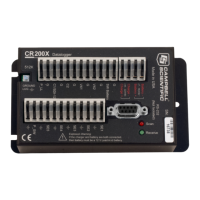Section 11. Programming Resource Library
121
Note Cup anemometers typically have a mechanical offset which is added to
each measurement. A numeric offset is usually encoded in the CRBASIC
program to compensate for the mechanical offset. When this is done, a
measurement will equal the offset only when wind speed is zero; consequently,
additional code is often included to zero the measurement when it equals the
offset so that WindVector () can reject measurements when wind speed is zero.
11.5.2.1 Measured Raw Data
• S
i
: horizontal wind speed
•
i
: horizontal wind direction
• Ue
i
: east-west component of wind
• Un
i
: north-south component of wind
• N: number of samples
11.5.2.2 Calculations
11.5.2.2.1 Input Sample Vectors
Figure 45: Input Sample Vectors
In FIGURE. Input Sample Vectors (p. 121) the short, head-to-tail vectors are the
input sample vectors described by s
i
and
i
, the sample speed and direction, or
by Ue
i
and Un
i
, the east and north components of the sample vector. At the end
of data storage interval T, the sum of the sample vectors is described by a vector
of magnitude U and direction u. If the input sample interval is t, the number of
samples in data storage interval T is N = T / t. The mean vector magnitude is Ū
= U / N.

